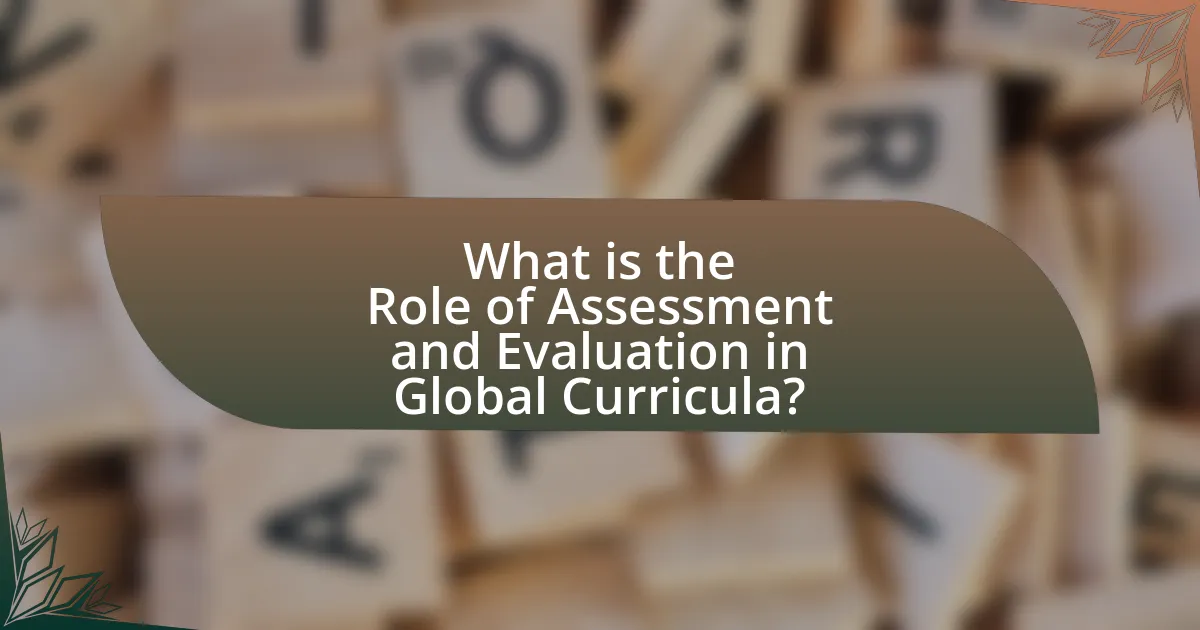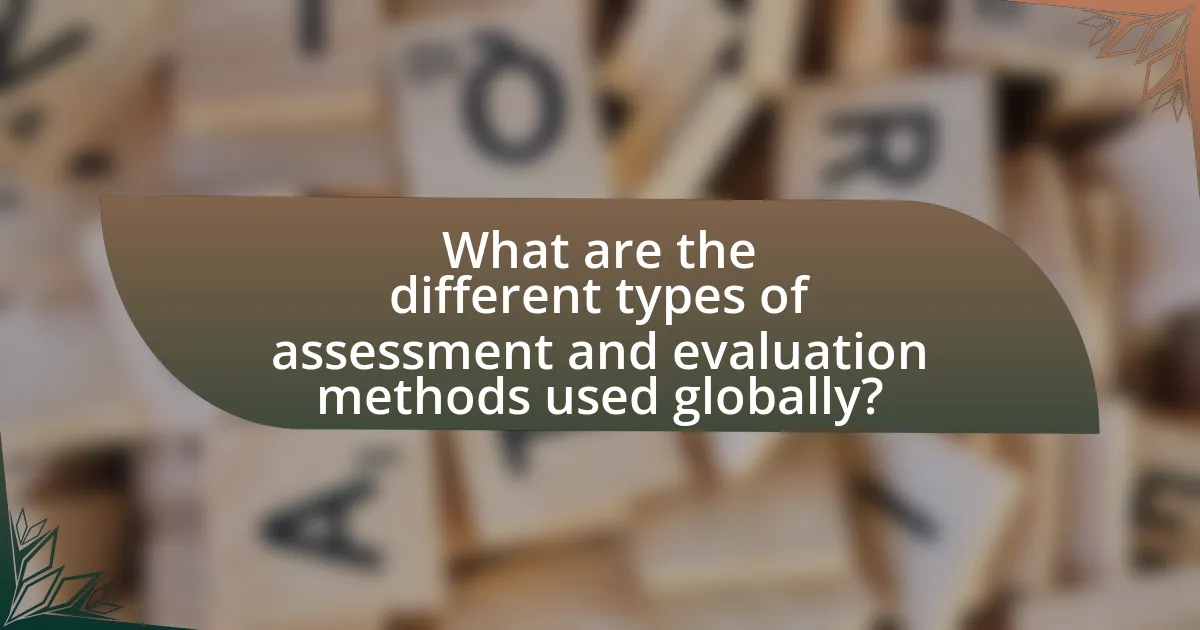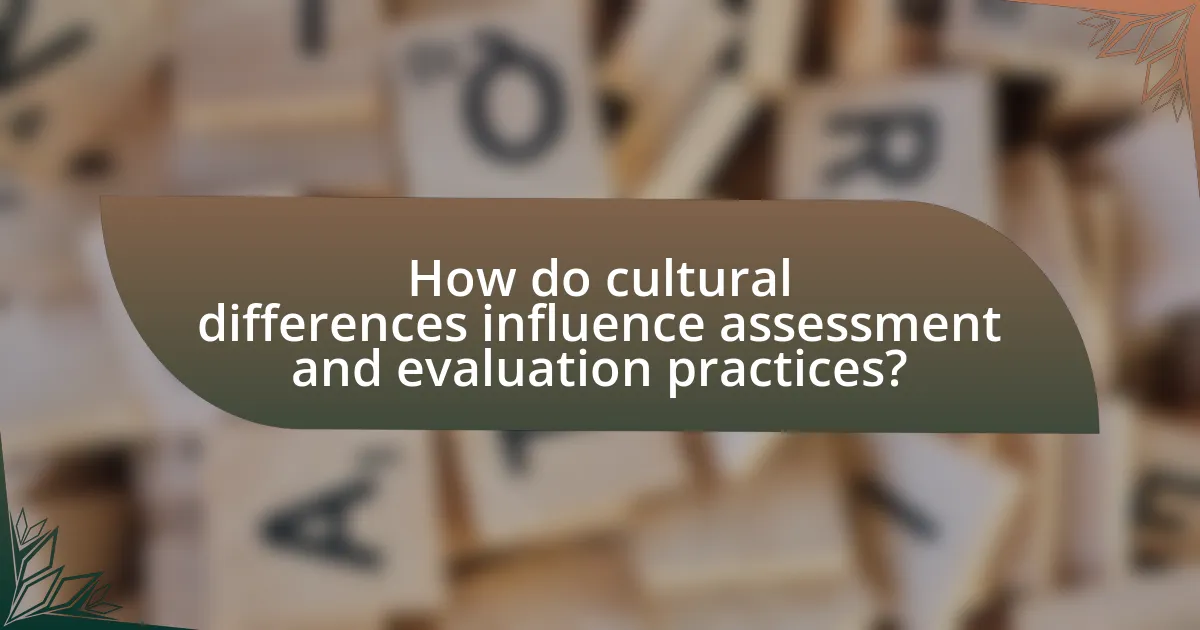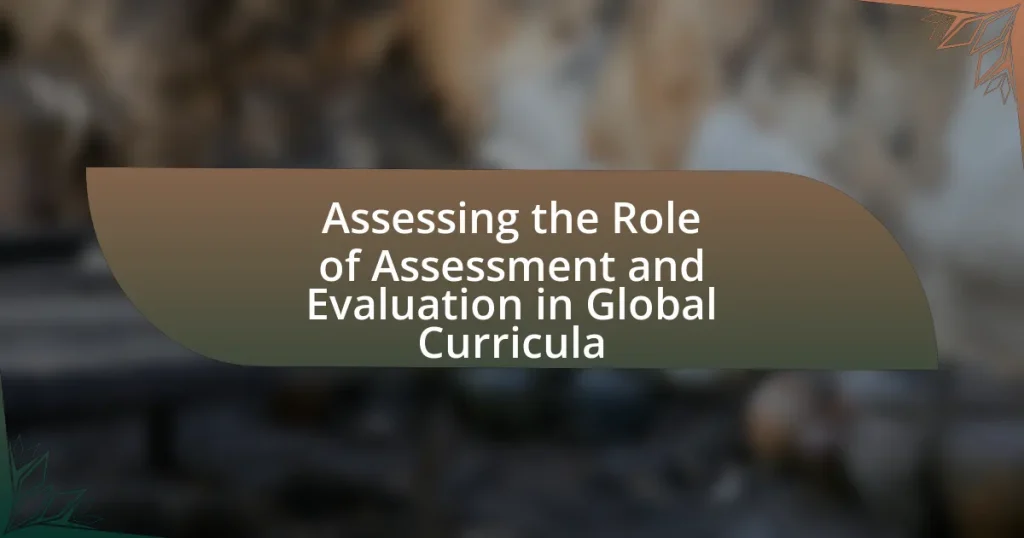The article examines the critical role of assessment and evaluation in global curricula, emphasizing their importance in measuring student learning outcomes and maintaining educational standards. It differentiates between assessment, a continuous process aimed at improving teaching and learning, and evaluation, a summative process that judges educational quality. Key components of assessment, including formative and summative methods, are discussed, along with their impact on student engagement and learning outcomes. The article also addresses the influence of cultural differences on assessment practices and highlights best practices for ensuring fairness and equity in evaluations, ultimately underscoring the necessity of effective assessment strategies in enhancing global education systems.

What is the Role of Assessment and Evaluation in Global Curricula?
Assessment and evaluation play a critical role in global curricula by measuring student learning outcomes and ensuring educational standards are met. These processes provide feedback to educators and learners, guiding instructional practices and curriculum development. For instance, standardized assessments, such as the Programme for International Student Assessment (PISA), offer comparative data on student performance across countries, highlighting areas for improvement and best practices. Furthermore, formative assessments help educators adjust teaching strategies in real-time, enhancing student engagement and understanding. Overall, effective assessment and evaluation are essential for maintaining quality and relevance in global education systems.
How do assessment and evaluation differ in educational contexts?
Assessment and evaluation differ in educational contexts primarily in their purpose and approach. Assessment is a continuous process aimed at gathering information about student learning to improve teaching and learning strategies, while evaluation is a summative process that judges the quality or value of educational outcomes based on specific criteria. For instance, formative assessments, such as quizzes and class discussions, provide ongoing feedback to enhance student performance, whereas evaluations, like final exams or standardized tests, measure overall achievement against predetermined standards. This distinction is supported by educational research, which indicates that effective assessment practices can lead to improved student engagement and learning outcomes, while evaluations serve to certify competency and inform stakeholders about educational effectiveness.
What are the key components of assessment in global curricula?
The key components of assessment in global curricula include formative assessment, summative assessment, standards alignment, and feedback mechanisms. Formative assessment involves ongoing evaluations during the learning process to monitor student progress and inform instruction. Summative assessment evaluates student learning at the end of an instructional unit by comparing it against some standard or benchmark. Standards alignment ensures that assessments are designed to measure the knowledge and skills outlined in educational standards, promoting consistency across different educational contexts. Feedback mechanisms provide students with information on their performance, guiding them toward improvement and deeper understanding. These components collectively enhance the effectiveness and relevance of assessments in diverse educational settings.
How does evaluation contribute to the effectiveness of global curricula?
Evaluation enhances the effectiveness of global curricula by providing measurable insights into student learning outcomes and instructional quality. Through systematic assessment methods, educators can identify strengths and weaknesses in curriculum design, ensuring alignment with educational standards and learner needs. For instance, the Programme for International Student Assessment (PISA) evaluates educational systems worldwide, offering data that informs curriculum improvements and teaching strategies. This evidence-based approach allows for continuous refinement of curricula, fostering better educational practices and outcomes across diverse contexts.
Why is assessment and evaluation important in education?
Assessment and evaluation are crucial in education because they provide measurable insights into student learning and instructional effectiveness. These processes enable educators to identify strengths and weaknesses in both teaching methods and student comprehension, facilitating targeted improvements. Research indicates that formative assessments can enhance student achievement by up to 30% when used effectively (Hattie, 2009, “Visible Learning”). Furthermore, evaluations help ensure accountability in educational systems, guiding policy decisions and resource allocation. By systematically analyzing educational outcomes, stakeholders can make informed decisions that enhance the overall quality of education.
What impact does assessment have on student learning outcomes?
Assessment significantly influences student learning outcomes by providing measurable indicators of student understanding and performance. It helps identify areas where students excel or struggle, allowing educators to tailor instruction accordingly. Research shows that formative assessments, such as quizzes and feedback, can enhance student engagement and motivation, leading to improved academic performance. For instance, a study by Black and Wiliam (1998) in “Assessment and Classroom Learning” found that formative assessment practices can raise student achievement by up to 30%. This evidence underscores the critical role of assessment in shaping effective learning experiences and outcomes.
How does evaluation inform curriculum development and improvement?
Evaluation informs curriculum development and improvement by providing data-driven insights into student learning outcomes and instructional effectiveness. Through systematic assessment, educators can identify strengths and weaknesses in the curriculum, allowing for targeted modifications that enhance educational quality. For instance, standardized test results can reveal gaps in student understanding, prompting curriculum adjustments to address those specific areas. Research indicates that programs utilizing continuous evaluation methods, such as formative assessments, show a 20% increase in student performance over those relying solely on summative assessments. This evidence underscores the critical role of evaluation in shaping responsive and effective curricula.

What are the different types of assessment and evaluation methods used globally?
The different types of assessment and evaluation methods used globally include formative assessment, summative assessment, diagnostic assessment, and norm-referenced assessment. Formative assessment occurs during the learning process to monitor student progress and provide ongoing feedback, while summative assessment evaluates student learning at the end of an instructional unit, often through standardized tests. Diagnostic assessment identifies students’ strengths and weaknesses before instruction begins, enabling tailored teaching approaches. Norm-referenced assessment compares a student’s performance against a group, often used in standardized testing to rank students. These methods are widely recognized and implemented in educational systems worldwide to enhance learning outcomes and inform teaching practices.
What are formative and summative assessments?
Formative assessments are tools used during the learning process to monitor student progress and provide ongoing feedback, enabling adjustments to teaching methods. Examples include quizzes, discussions, and peer reviews, which help educators identify areas where students may need additional support. Summative assessments, on the other hand, evaluate student learning at the end of an instructional unit by measuring knowledge and skills against established benchmarks. Common forms include final exams, standardized tests, and end-of-term projects, which serve to determine if learning objectives have been met. Both types of assessments play crucial roles in educational settings, as formative assessments guide instruction while summative assessments measure overall achievement.
How do formative assessments enhance learning during the educational process?
Formative assessments enhance learning during the educational process by providing ongoing feedback that informs both teaching and student understanding. This continuous feedback loop allows educators to identify areas where students struggle and adjust instruction accordingly, promoting a more tailored learning experience. Research indicates that formative assessments can lead to a 20-30% increase in student achievement, as they encourage active engagement and self-reflection among learners. By integrating formative assessments into the curriculum, educators can foster a growth mindset, enabling students to take ownership of their learning and improve their academic performance.
What role do summative assessments play in measuring overall achievement?
Summative assessments play a critical role in measuring overall achievement by evaluating student learning at the end of an instructional unit. These assessments provide a comprehensive overview of what students have learned and how well they have met the learning objectives. For instance, standardized tests, final exams, and end-of-term projects are common forms of summative assessments that quantify student performance and understanding. Research indicates that summative assessments can significantly influence educational outcomes, as they often inform curriculum adjustments and instructional strategies based on aggregated student performance data.
What alternative assessment methods are being utilized in global curricula?
Alternative assessment methods utilized in global curricula include portfolio assessments, performance-based assessments, and peer assessments. Portfolio assessments allow students to showcase their work over time, demonstrating growth and understanding in various subjects. Performance-based assessments require students to apply their knowledge in real-world scenarios, often through projects or presentations, which can enhance critical thinking and problem-solving skills. Peer assessments involve students evaluating each other’s work, fostering collaboration and reflective learning. These methods are increasingly adopted to provide a more comprehensive evaluation of student learning beyond traditional testing, aligning with educational trends that emphasize skills such as creativity, collaboration, and communication.
How do performance-based assessments differ from traditional methods?
Performance-based assessments differ from traditional methods by focusing on the demonstration of skills and knowledge through real-world tasks rather than relying solely on standardized tests or written exams. Traditional methods typically assess students’ understanding through multiple-choice questions or essays, which may not accurately reflect their practical abilities. In contrast, performance-based assessments require students to engage in activities such as projects, presentations, or simulations, allowing for a more comprehensive evaluation of their competencies. Research indicates that performance-based assessments can lead to deeper learning and better retention of knowledge, as they encourage critical thinking and problem-solving skills, which are essential in today’s global curricula.
What is the significance of portfolio assessments in education?
Portfolio assessments are significant in education as they provide a comprehensive view of a student’s learning progress and achievements over time. These assessments allow educators to evaluate not only the final products of student work but also the processes involved in creating those products, fostering a deeper understanding of student capabilities. Research indicates that portfolio assessments can enhance student motivation and engagement, as they encourage self-reflection and ownership of learning. For instance, a study by Paulson, Paulson, and Meyer (1991) highlights that portfolios promote critical thinking and self-assessment skills, which are essential for lifelong learning.

How do cultural differences influence assessment and evaluation practices?
Cultural differences significantly influence assessment and evaluation practices by shaping the values, expectations, and methods used in educational contexts. For instance, collectivist cultures may prioritize group assessments and collaborative learning, while individualistic cultures often emphasize personal achievement and standardized testing. Research by Hofstede (1980) highlights how cultural dimensions, such as individualism versus collectivism, directly impact educational approaches and assessment criteria. Additionally, studies show that cultural context affects students’ responses to assessments, as seen in the varying interpretations of feedback and grading systems across cultures. This evidence underscores the necessity for educators to adapt assessment practices to align with cultural norms and values to ensure fairness and effectiveness in evaluation.
What challenges arise from implementing standardized assessments globally?
Implementing standardized assessments globally presents challenges such as cultural bias, logistical issues, and varying educational standards. Cultural bias arises because assessments may not account for diverse educational contexts and learning styles, leading to unfair evaluations of students from different backgrounds. Logistical issues include the difficulty of administering assessments across different regions, which can involve varying resources, infrastructure, and technology access. Additionally, differing educational standards and curricula across countries complicate the creation of a universally applicable assessment, as what is deemed essential knowledge can vary significantly. These challenges highlight the complexities involved in achieving equitable and effective global assessment practices.
How do cultural perceptions of education affect assessment strategies?
Cultural perceptions of education significantly influence assessment strategies by shaping what is valued in learning and how success is measured. For instance, in collectivist cultures, assessments may prioritize group work and collaborative projects, reflecting the cultural emphasis on community and teamwork, while individualistic cultures may focus on standardized testing and personal achievement. Research indicates that these cultural frameworks can lead to varying expectations regarding student performance and the types of assessments deemed appropriate. For example, a study by Hofstede (1986) highlights how cultural dimensions, such as individualism versus collectivism, directly impact educational practices and assessment methods across different societies.
What adaptations are necessary for assessments to be culturally relevant?
Culturally relevant assessments require adaptations such as incorporating local contexts, languages, and cultural norms into the evaluation process. These adaptations ensure that assessments reflect the diverse backgrounds of learners, making them more relatable and effective. For instance, using examples and scenarios that resonate with students’ cultural experiences can enhance engagement and understanding. Research indicates that culturally responsive assessments improve student performance and motivation, as they validate students’ identities and experiences (Gay, 2010).
How can educators ensure fairness and equity in assessment and evaluation?
Educators can ensure fairness and equity in assessment and evaluation by implementing standardized assessment practices that accommodate diverse learning needs. This includes using multiple assessment methods, such as formative and summative assessments, to capture a comprehensive understanding of student learning. Research indicates that differentiated assessments can lead to improved student outcomes, as they allow for varied expressions of knowledge and skills, catering to individual strengths and challenges. For instance, a study by Tomlinson (2001) highlights that differentiated instruction and assessment can significantly enhance student engagement and achievement across diverse classrooms. By actively involving students in the assessment process and providing clear criteria, educators can further promote transparency and equity in evaluations.
What strategies can be employed to minimize bias in assessments?
To minimize bias in assessments, employing standardized assessment tools and procedures is essential. Standardization ensures that all test-takers are evaluated under the same conditions, reducing variability that can lead to biased outcomes. Additionally, incorporating diverse perspectives in the development of assessment materials can help identify and eliminate potential biases. Research indicates that assessments designed with input from a diverse group of stakeholders are more likely to be fair and equitable. Furthermore, training assessors to recognize and mitigate their own biases can significantly enhance the objectivity of evaluations. Studies show that assessor training programs that focus on bias awareness lead to more accurate and fair assessments.
How can technology support equitable assessment practices?
Technology can support equitable assessment practices by providing accessible tools and resources that cater to diverse learning needs. For instance, adaptive learning platforms can personalize assessments based on individual student performance, ensuring that all learners are evaluated fairly according to their unique abilities. Research indicates that technology-enhanced assessments, such as online quizzes and interactive simulations, can reduce biases by standardizing the evaluation process, allowing for consistent measurement across different demographics. Furthermore, data analytics can identify gaps in student understanding, enabling educators to adjust their teaching strategies to support underrepresented groups effectively.
What best practices should educators follow for effective assessment and evaluation?
Educators should follow best practices such as aligning assessments with learning objectives, utilizing a variety of assessment methods, providing timely feedback, and involving students in self-assessment. Aligning assessments with learning objectives ensures that evaluations measure the intended skills and knowledge, which is supported by research indicating that clear alignment improves student performance (Wiggins & McTighe, 2005). Utilizing diverse assessment methods, including formative and summative assessments, caters to different learning styles and provides a comprehensive view of student understanding. Timely feedback is crucial, as studies show that prompt responses to student work can enhance learning outcomes (Hattie & Timperley, 2007). Involving students in self-assessment fosters metacognitive skills and encourages ownership of their learning process, which has been linked to increased motivation and achievement (Boud, 1995).
How can continuous feedback improve the assessment process?
Continuous feedback enhances the assessment process by providing timely insights that allow for immediate adjustments in learning strategies. This ongoing dialogue between educators and learners fosters a more adaptive learning environment, enabling students to understand their strengths and weaknesses in real-time. Research indicates that continuous feedback can lead to a 30% increase in student performance, as it encourages active engagement and promotes a growth mindset. By integrating regular feedback mechanisms, such as formative assessments and peer reviews, the assessment process becomes more dynamic and responsive, ultimately improving educational outcomes.
What role does professional development play in enhancing assessment skills?
Professional development plays a crucial role in enhancing assessment skills by providing educators with the knowledge and tools necessary to implement effective assessment strategies. Through targeted training and workshops, educators learn to design assessments that accurately measure student learning outcomes, align with curriculum standards, and incorporate diverse assessment methods. Research indicates that teachers who engage in ongoing professional development are more likely to adopt innovative assessment practices, leading to improved student performance. For instance, a study by the National Staff Development Council found that professional development focused on assessment resulted in a 20% increase in student achievement in schools that implemented these strategies.
